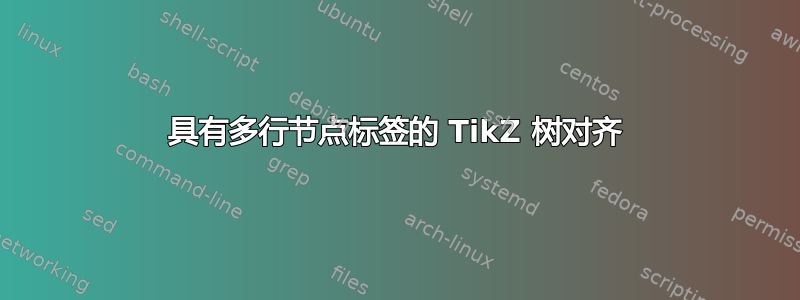
我正在尝试在 tikZ 中创建一个树结构,它看起来离我想要的不太远,但是存在一些问题:
- 标签是多行的,这似乎有点破坏了边缘的对齐。边缘应该以更居中的方式延伸。
- 树中仍有很多重叠,如果我再多玩一下兄弟距离,也许可以做到这一点?我只是还不确定如何做到这一点,如果有更简单的方法,我很高兴听到。
- 为了每个叶节点我想发表一条文字标签下方。对于这一点,我还不确定该如何做,因为我想在叶子标签周围画一个圆圈(以叶子标签为例
R\\(0, 0),但文本应该在圆圈外面,在圆圈下面。
这就是树的当前样子。对齐/重叠问题仍然非常明显:
源代码(可通过 编译pdflatex)在这里
\documentclass{article}
\usepackage[usenames]{color}
\usepackage[utf8]{inputenc}
\usepackage[T1]{fontenc}
\usepackage{graphicx}
\usepackage{longtable}
\usepackage{wrapfig}
\usepackage{rotating}
\usepackage[normalem]{ulem}
\usepackage{amsmath}
\usepackage{amssymb}
\usepackage{capt-of}
\pagestyle{empty} % do not remove
% The settings below are copied from fullpage.sty
\setlength{\textwidth}{\paperwidth}
\addtolength{\textwidth}{-3cm}
\setlength{\oddsidemargin}{1.5cm}
\addtolength{\oddsidemargin}{-2.54cm}
\setlength{\evensidemargin}{\oddsidemargin}
\setlength{\textheight}{\paperheight}
\addtolength{\textheight}{-\headheight}
\addtolength{\textheight}{-\headsep}
\addtolength{\textheight}{-\footskip}
\addtolength{\textheight}{-3cm}
\setlength{\topmargin}{1.5cm}
\addtolength{\topmargin}{-2.54cm}
\usepackage{tikz}
\usepackage{caption}
\begin{document}
\usetikzlibrary{graphs,graphs.standard}
\usetikzlibrary{decorations, decorations.text,backgrounds}
\begin{figure}
\centering
\begin{tikzpicture}[
level distance=20mm,
level 1/.style={sibling distance=50mm},
level 2/.style={sibling distance=30mm},
level 3/.style={sibling distance=20mm},
level 4/.style={sibling distance=10mm},
scale=1.4,transform shape]
\node[label={[align=center]X\\(2, 2)}] {}
child {node[label={[align=center]Y\\(0, 2)}] {}
child {node[label={[align=center]X\\(0, 1)}] {}
child {node[label={[align=center]Y\\(0, 0)}] {}}
}
child {node[label={[align=center]X\\(0, 0)}] {}}
}
child {node[label={[align=center]Y\\(1, 2)}] {}
child {node[label={[align=center]X\\(0, 2)}] {}
child {node[label={[align=center]Y\\(0, 0)}] {}}
child {node[label={[align=center]Y\\(0, 1)}] {}
child {node[label={[align=center]X\\(0, 0)}] {}}
}
}
child {node[label={[align=center]X\\(1, 1)}] {}
child {node[label={[align=center]Y\\(0, 1)}] {}
child {node[label={[align=center]X\\(0, 0)}] {}}
}
child {node[label={[align=center]Y\\(1, 0)}] {}
child {node[label={[align=center]X\\(0, 0)}] {}}
}
}
child {node[label={[align=center]X\\(1, 0)}] {}
child {node[label={[align=center]Y\\(0, 0)}] {}}
}
};
\end{tikzpicture}
\caption*{\huge Question 2 a), the simplified game tree, since we can assume $(a, b) = (b, a)$.}
\end{figure}
\end{document}
答案1
为您指明正确方向的东西——改编自——控制 tikz 树
\documentclass[border=10pt]{standalone}
\usepackage{tikz}
\tikzset{
treenode/.style = {shape=rectangle, rounded corners,
draw, align=center, font=\scriptsize},
root/.style = {treenode},
env/.style = {treenode},
every node/.style = {font=\tiny},
}
\begin{document}
\begin{tikzpicture}
[
grow = down,
level 1/.style = {sibling distance=5cm},
level 2/.style = {sibling distance=2.5cm},
level 3/.style = {sibling distance=1.5cm},
level distance = 1.2cm,
edge from parent/.style = {draw, edge from parent path={(\tikzparentnode) -- (\tikzchildnode)}},
]
\node [root] {X\\22}
child { node [env] {Y\\02}
child { node [env] {X\\01}
child{ node [env,label=below:Leaf 1] {Y\\00}}
}
child{ node [env,label=below:Leaf 2] {X\\01}
}
}
child { node [env] {Y\\12}
child{ node [env] {X\\12 }
child{ node [env,label=below:Leaf 4] {Y\\00}
}
child{ node [env,label=below:Leaf 5] {Y\\01}
}
}
child{ node [env] {X\\11}
child { node [env] {Y\\01}
child{ node [env,label=below:Leaf 6] {X\\00}}
}
child{ node [env,] {Y\\01}
child{ node [env,label=below:Leaf 7] {X\\00}}}
}
child{ node [env] {X\\10}
child{ node [env,label=below:Leaf 8] {Y\\00}
}
}
};
\end{tikzpicture}
\end{document}
答案2
另外,您可以使用forest,这将使您更轻松地格式化叶子。
\documentclass{article}
\usepackage{forest}
\begin{document}
\begin{forest}
for tree={
parent anchor=south, child anchor=north,
align=center,
s sep=6mm, l sep=8mm,
if n children=0{draw, circle, minimum size=8mm, inner sep=0pt, fit=band}{}
}
[{X\\(2,2)}
[{Y\\(0,2)}
[{X\\(0,1)}
[{Y\\(0,0)}, label=below:text]
]
[{X\\(0,0)}, label=below:text]
]
[{Y\\(1,2)}
[{X\\(0,2)}
[{Y\\(0,0)}, label=below:text]
[{Y\\(0,1)}
[{X\\(0,0)}, label=below:text]
]
]
[{X\\(1,1)}
[{Y\\(0,1)}
[{X\\(0,0)}, label=below:text]
]
[{Y\\(1,0)}
[{X\\(0,0)}, label=below:text]
]
]
[{X\\(1,0)}
[{Y\\(0,0)}, label=below:text]
]
]
]
\end{forest}
\end{document}
答案3
和istgame:
添加:使用\xtShowTerminalNodes和\istbt:
\documentclass[border=5mm]{standalone}
\usepackage{istgame}
\usepackage{makecell}
\NewDocumentCommand\mline{O{c}+m}{\makecell[#1]{#2}}
\begin{document}
\begin{istgame}[font=\scriptsize]
\setistmathTF*000 % all labels in text mode
\tikzset{oval node/.style={ellipse node,draw,circle,minimum size=2.8em}}
\xtShowTerminalNodes[oval node] %%% show terminal nodes
% tree
\xtdistance{20mm}{70mm}
\istrooto(0){\mline{X\\(2,2)}} \istb[blue,thick] \istb[red,very thick] \endist
% left part: blue
\xtdistance{20mm}{30mm}
\istrooto(L)(0-1){\mline{Y\\$(0,2)$}} \istb \istbt{}{\mline{X\\$(0,0)$}}[center] \endist
\xtPayoff*(L-2){\mline{text\\below}}[below=1.3em]
\istrooto(L1)(L-1){\mline{X\\$(0,1)$}} \istbt{}{\mline{Y\\$(0,0)$}}[center] \endist
\xtPayoff*(L1-1){\mline{text\\outside}}[below=1.3em]
% right part: red
\xtdistance{20mm}{30mm}
\istrooto(R)(0-2){\mline{Y\\$(1,2)$}} \istb \istb \istb \endist
\xtdistance{20mm}{15mm}
\istrooto(R1)(R-1){\mline{X\\$(0,2)$}} \istbt{}{\mline{Y\\$(0,0)$}}[center] \istb \endist
\xtPayoff*(R1-1){text 1}[below=1.3em]
\istrooto(R2)(R-2){\mline{X\\$(1,1)$}} \istb \istb \endist
\istrooto(R3)(R-3){\mline{X\\$(1,0)$}} \istbt{}{\mline{Y\\$(0,0)$}}[center] \endist
\xtPayoff*(R3-1){text 2}[below=1.3em]
\istrooto(R12)(R1-2){\mline{Y\\$(0,1)$}} \istbt{}{\mline{X\\$(0,0)$}}[center] \endist
\xtPayoff*(R12-1){text 3}[below=1.3em]
\istrooto(R21)(R2-1){\mline{Y\\$(0,1)$}} \istbt{}{\mline{X\\$(0,0)$}}[center] \endist
\xtPayoff*(R21-1){text 4}[below=1.3em]
\istrooto(R22)(R2-2){\mline{Y\\$(1,0)$}} \istbt{}{\mline{X\\$(0,0)$}}[center] \endist
\xtPayoff*(R22-1){text 5}[below=1.3em]
\end{istgame}
\end{document}
原来的:
\documentclass[border=5mm]{standalone}
\usepackage{istgame}
\usepackage{makecell}
\NewDocumentCommand\mline{O{c}+m}{\makecell[#1]{#2}}
\begin{document}
\begin{istgame}[font=\scriptsize]
\setistmathTF*000 % all labels in text mode
\tikzset{oval node/.style={ellipse node,draw,circle}}
% tree: root
\xtdistance{20mm}{70mm}
\istrooto(0){\mline{X\\(2,2)}}
\istb[blue,thick]
\istb[red,very thick]
\endist
% left part: blue
\xtdistance{20mm}{30mm}
\istrooto(L)(0-1){\mline{Y\\$(0,2)$}} \istb \istb \endist
\xtOwner*(L){\mline{text\\left-side}}[left=1.3em,blue]
\istrooto(L1)(L-1){\mline{X\\$(0,1)$}} \istb \endist
\istrooto(L2)(L-2){\mline{X\\$(0,0)$}} \endist
\xtPayoff*(L2){\mline{text\\below}}[below=1.3em]
\istrooto(L11)(L1-1){\mline{Y\\$(0,0)$}} \endist
\xtPayoff*(L11){\mline{text\\outside}}[below=1.3em]
% right part: red
\xtdistance{20mm}{30mm}
\istrooto(R)(0-2){\mline{Y\\$(1,2)$}} \istb \istb \istb \endist
\xtdistance{20mm}{15mm}
\istrooto(R1)(R-1){\mline{X\\$(0,2)$}} \istb \istb \endist
\istrooto(R2)(R-2){\mline{X\\$(1,1)$}} \istb \istb \endist
\istrooto(R3)(R-3){\mline{X\\$(1,0)$}} \istb \endist
\istrooto(R11)(R1-1){\mline{Y\\$(0,0)$}} \endist
\xtPayoff*(R11){text 1}[below=1.3em]
\istrooto(R12)(R1-2){\mline{Y\\$(0,1)$}} \istb \endist
\istrooto(R21)(R2-1){\mline{Y\\$(0,1)$}} \istb \endist
\istrooto(R22)(R2-2){\mline{Y\\$(1,0)$}} \istb \endist
\istrooto(R31)(R3-1){\mline{Y\\$(0,0)$}} \endist
\xtPayoff*(R31){text 2}[below=1.3em]
\istrooto(R121)(R12-1){\mline{X\\$(0,0)$}} \endist
\xtPayoff*(R121){text 3}[below=1.3em]
\istrooto(R211)(R21-1){\mline{X\\$(0,0)$}} \endist
\xtPayoff*(R211){text 4}[below=1.3em]
\istrooto(R221)(R22-1){\mline{X\\$(0,0)$}} \endist
\xtPayoff*(R221){text 5}[below=1.3em]
\end{istgame}
\end{document}







